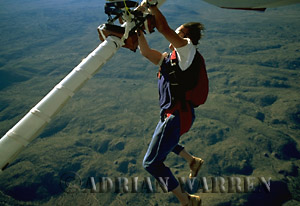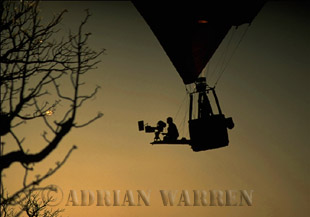By Adrian Warren
What lens?
Wider angle lenses will tend to help problems of unsteadiness or vibration, except that the wider the lens angle, the more restricted the camera moves (e.g. in the open doorway of a Cessna 182, with a 7mm lens designed for super-16mm., you have to lean out quite a long way into the airstream in order to keep the wing tip, wing strut, wheel and tail plane out of frame, and there is therefore no room for moving the camera in shot - the shot has to be flown by the pilot and all the camera operator can do is to hold the camera steady.)
What frame speed?
Normal frame speed is 24/25 fps - generally speaking, a higher frame speed will tend to help problems of unsteadiness or vibration. However, if you film everything at 75 fps your 10 minute 400 foot roll will only last 3 minutes and 20 seconds.
The Camera Operator
The aircraft working environment is a specialised one: the camera operator needs to feel comfortable in it. With the aircraft door removed, and making extreme manoeuvres, with bumpy air, vibration, wind, and cold, you can feel quite exposed. With the proper harnesses for the operator and the equipment, however, you learn to relax. It is, however, very important to have a high standard of self discipline and order in the aircraft: as a camera operator, you are usually on your own in the rear cabin, and the pilot will have his back to you. Loose articles will blow about and disappear out of the door. Very careful thought must be applied before take off so you have exactly what you need within reach and securely stowed until required. And it will be the pilot's responsibility to ensure that you know, before take off, exactly what you must do in the event of any aircraft emergency.
The Pilot
It is important to know the pilot's level of flying experience; some production companies, broadcasting organisations, and production insurance companies, insist that a pilot flying a filming operation should have a minimum of a Commercial Pilot's Licence. Unfortunately, just because a pilot has that level of licence does not mean he/she is going to be any good at flying for filming, which often requires flying at very low levels and in tight places such as gorges or canyons. On the other hand we can often be too critical of a pilot's performance when evaluating footage. The aircraft's own limitations can be a deciding factor under certain conditions, for example high altitude in mountainous areas where the thinner air makes for sloppy aircraft responses; or unusual manoeuvres in a helicopter that is not designed for it. Furthermore, the director or camera operator may be keen to push the limits in order to achieve an amazing piece of footage, but it should be remembered that the pilot must always have the last word in assessing what is or is not possible, in the interests of safety.
AERIAL PLATFORMS
What Kind of Aircraft?
Your choice of aircraft for camera platform will be determined by three questions. Firstly, it is a question of how much money you have available in the budget. Mostly, aircraft are hired by the hour; with single engine Cessnas at the cheaper end of the scale, and helicopters and Lear Jets at the expensive end. But it will also be determined by what is available on location, and into this formula there should be an assessment of safety factors - how well the aircraft has been maintained, and the level of experience of the pilot. Thirdly, the choreography of the shots required for the film may demand a special approach and you may need to put money from the budget into bringing a certain kind of aircraft in from elsewhere in order to achieve the aerials shots you have story boarded.
Let's take a look at the different possibilities:
1. Fixed wing:
(i) Propeller - single engine
Most commonly used type is Cessna, with a high wing giving good downward visibility; generally economic; user friendly; easy to remove door, although some pilots are initially unwilling, and may suggest you film out of the window. In my opinion this is inadequate and you should use your powers of persuasion to get the door off - it'll be worth it.
There are various different types of Cessna. My personal preference is for a nose wheel rather than a tail wheel, simply for convenience and comfort on the ground, and when using an exterior camera mount which we'll look at later on, it's easier to find the correct angle to pre-set the camera with a nose wheel model. Having said that, the tail wheel Cessna 185 is a good four place aircraft with a powerful engine and good short field landing performance. Of the nose wheel models, my preference goes to a Cessna 182 - it is probably the most manoeuvrable of the single engine Cessnas; has plenty of room inside, and plenty of power to get you out of trouble. The Cessna 172 is also good, but not as powerful. The Cessna 206 or 207 is a larger aircraft and more expensive, underpowered and heavy in manoeuvres, unless you are lucky to find one with a turbo injected engine. The Cessna 150 or 152 have only two seats, and therefore very cramped and lack engine power when fully loaded. The Cessna 210 is a six place aircraft, and (except for early models) has no wing strut.
If you are looking for high altitude work, the Pilatus Turbo Porter is an excellent aircraft, though expensive. It has a high wing, like the Cessna, and a big door from which to film.
(ii) Propeller - multi-engine
Multi-engine aircraft are generally inappropriate for aerial filming, although a few types have been modified to take cameras in the nose cone for forward facing shots. This, though, is an expensive modification. Otherwise, the engines, placed as they are out on the wing, get in the way of photography, and the costs per hour are extremely high.
If you have to go for multi-engine aircraft for any particular reason, there are a few high wing types to choose from, including Britten-Norman Islander, and Twin Otter, both of which have large side doors for good viewing, and you might consider the Cessna 337, which has the two engines positioned in line fore and aft of the fuselage in a "push-pull" arrangement.
(iii) Gliders
Free or motorised, they are not the easiest of aircraft to work from. They are cramped inside, the field of view is very limited, as is the range or endurance. A glider did prove useful though when we were filming migrating storks and pelicans over Israel; we found it possible to soar with the birds, and filmed some interesting shots.
(iv) Microlights
Uncomfortable for hand holding the camera; subject to limitations on flight conditions - microlights, or ultralights, require very smooth air and light winds; although there are advantages in economy; lack of need for an airstrip; and flight speed is very slow.


